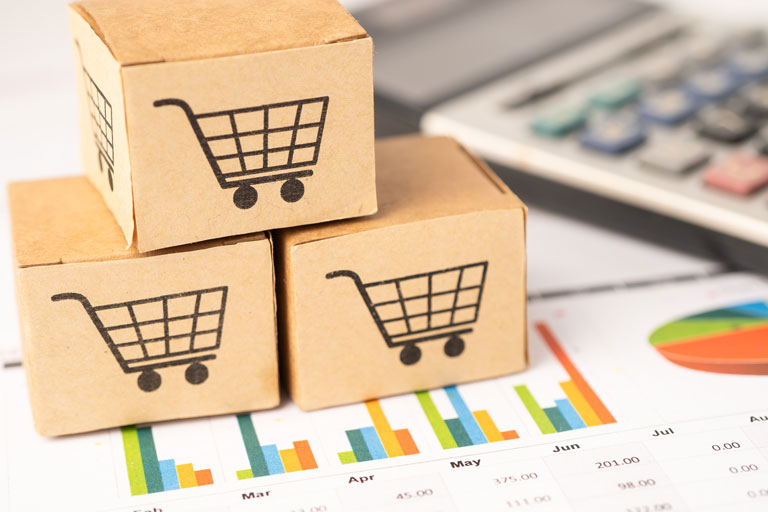You can’t really get where you want to go without a road map unless your destination is a movie about two middle-aged women running from the law after a road trip goes wrong. But if you’re not Thelma or Louise and you’re looking for some guidance on how to increase your sales, you need a plan.
For many retail businesses, that plan can be provided by some analytics. And as it turns out, one of the best places for collecting information to analyze is the point of sale.
Retail AI
Many businesses have long since graduated from the fly-by-night approach of using guesswork to make decisions. At least 33% of large-sized businesses will practice decision intelligence by the end of 2023. That is, they’ll collect data to make smarter decisions.
And part of the valuable insights provided by these data points is the rapidity with which business decisions can be made. Data analytics helped increase the speed of decision-making fivefold for businesses looking at customer behavior.
The Covid Pandemic increased the usage of this decision intelligence for businesses of all sizes. Since many businesses migrated to online models either entirely or in part, they were able to make greater use of analytic tools that can track the customer journey and provide more nuanced suggestions for both customers and business owners.
From the customer end, machine learning algorithms are using historical data like searches, verified purchase reviews, and past purchases to make tailored recommendations to shoppers. While upselling has long been part of the sales process, in some cases increasing conversions ninefold, modeling those recommendations based on historical data has the potential to close even more sales.
From the business end of things, software can be used to dissect customer behaviors. Even to the extent of seeing how they move their mouse around the page. Businesses can respond by updating the user experience of their platform, identifying pain points for instance, and removing them from the process.
The CJA (customer journey analysis) market alone was already valued at $10 billion in 2021. But it is expected to grow at a CAGR of more than 20% until 2029 when it will reach a $44 billion valuation.
Perhaps even more significant and conversation-inducing is the fact that more than half of these businesses will not be enterprise organizations; Rather, small and medium-sized businesses. This tells you two things: (1) there is a growing SaaS (software as a service) market for retail analytics and (2) business owners are recognizing the importance of analytics.
What Are Retail Analytics and What Do They Do?
Retail analytics is the process of using data to analyze inventory, supply chain, consumer demand, and sales. In other words, look at the numbers of the complex ecosystem of moving whatever is that your business sells from its source into the hands of your customers. While a number of these topics only concern goods, retail analytics can certainly be used for service-based businesses too.
Improve Sustainability & Stock
Retail analytics has the powerful potential to make the world a better place, and that’s no mere platitude. For example, grocery stores are turning to analytics to reduce food waste. This will not only improve their bottom line but assist in feeding hungry stomachs and reducing pollution. Since up to 10% of greenhouse gas emissions are attributable to yucky veggies (yuck) and rancid meat (super yuck), among other wasted edibles.
Analytics in the supply chain also makes sure that hospitals have the supplies they need to take care of patients. Which in some instances can literally be the difference between life and death.
Using retail analytics to monitor an entire ecosystem is an important part of their comprehensive implementation. But from the standpoint of a small (and perhaps even midsize business), some forms of retail analysis will be more important than others.
Monitor Supply Chain
Brands like Walmart and Target stand to benefit more from supply chain analysis since much of their inventory is sourced internally (e.g. their particular branding). But for a midsize chain retailer or a main street brick-and-mortar family-owned business receiving their inventory from vendors, supply chain analysis is somewhat of a moot point. Instead, a retail analysis could focus on inventory and sales.
Track Product Journeys to Increase Effective Sales
Inventory planning software can track the journey of items in the store, how long they sit on the shelf, or if there are particular times when a certain item is a better seller. Businesses could respond (for example) by moving a slow-moving item to a more prominent location to increase sales. Or as an opposite retail strategy, place a fast-moving item in the same location
Hoping to build on its already historically demonstrated popularity. There is a huge opportunity in this particular software market. Because around 43% of businesses track inventory manually or don’t bother to track it at all, resulting in fulfillment accuracies of around 63%.
Maximize Marketing Strategies
Retail analytics tools can bridge that gap between knowledge and performance. For example, manually entering items into a spreadsheet still requires some planning and execution. Especially if other crucial indicators are missing, such as timing and sales volume.
If the owner of a pet store knows that Fancy Feast is flying off the shelves mid-month, they can time their ordering better and maximize the marketing strategies on the ground floor. Perhaps, for instance, a Fancy Feast tasting party. Where one lucky manager dresses up as the white-gloved butler from those memorable commercials. Kitty nibble aside, an enterprising retail business owner will quickly recognize how leveraging big data can plug into their particular marketplace and act accordingly.
Improve Conversion Rates
Inventory planning is also of great assistance in terms of improving conversion rates. It can help store owners make sure they have what they need, and less of what they don’t. As slow-moving inventory can be the bane of a business owner’s existence, retail analytics can greatly improve operations by making sure that money is being put into the right places. And in a related vein, another great source of data can be the POS system right at the cash register.

How Do You Collect Retail Analytics?
CNBC says that American retailers (75 of them, at least) are leveraging location data to actually track customer journeys in the store, and using that to push products and discounts. Try it out next time you’re in a large brand-name retailer. You might find that their store app pushes products that you happened to linger by. Much in the same way that stopping for a few seconds on a social media post will result in more of that type of content appearing in your home feed.
And while that idea certainly opens up some discussion about consumer privacy, so far it’s not a relevant concern for small and midsize businesses. For these businesses (and even the big businesses using location data) the point of sale is the most concrete place to collect retail analytics.
That’s because there is nothing more final than a sale. And even those sales that aren’t final (e.g. those resulting in a return or an exchange). Thus, yielding some valuable insights into customer behavior).
While it’s possible to track some of this behavior with cash purchases, it’s much easier if you have a payment processor that can integrate with some analytics to break down information. Like what was purchased, how much of it, and whether it paired with anything else.
When it comes to using payments to collect information, there are a few different types of informative categories. Some of which relate to your customer and some that relate to you and your business.
How Can a POS Terminal Collect Customer Data?
Point-of-sale inventory data uses the SKU of the sold item to adjust the tally of how many units there are. This can help you responsively adjust to the laws of supply and demand. POS sales data will provide you with macro-level accounting such as gross and net sales over a given time period. While micro-level accounting lets you know about average order value, average items per order, and net sales for the day.
POS product data helps you break down what are your hottest selling and/or most profitable products Yes, they may not be the same. And POS customer data can show you how long a particular shopper has been a customer, how often they shop with you, how much they spend, and what they buy.
CRM Software
While POS inventory, sales, and product data can be collected with a UPC code alone, a little bit more work is needed to mine customer data. In the case of brick-and-mortar businesses, you cannot really store credit card, debit card, or mobile wallet information to obtain long-term historical data on customer behavior.
And while online retail venues can leverage tokenization to save payment information (to improve the rapidity of the checkout experience), that is mainly a security function and less of an analytic tool. That’s why businesses often pair the shopping cart with a customer account, which feeds into CRM software customer relationship management.
Collecting POS customer data is, therefore, best served when the payment processor can integrate with some sort of CRM. Which via a platform dashboard, can give you some macro and micro insights on your entire customer base and specific customers. Getting customers into your CRM is a matter of collecting information like name, email address, and phone number.
While this can be a somewhat seamless process online, it can be more cumbersome and intrusive at a brick-and-mortar point-of-sale. A business owner will have to find the right balance of getting the information they need without pushing customers away. But once this customer information is gleaned, how exactly can it be harvested for tangibly useful insights?

How Can Retail Analytics Help Your Business?
It’s not necessarily what you know, but what you do with what you know. Retail analytics is only going to help your business if they are paired with some action. Fortunately, there are many actions you can take to help turn retail analytics into increased sales.
Leverage Customer Behavior Patterns
For brick-and-mortar businesses, one such technique was mentioned already: repositioning inventory in response to macro-level customer behavior. But for online businesses, the same thing can be done with a banner. It can display a particular product or service in a prominent location on your site, such as the homepage. You could also pair customer behavior patterns with email marketing, sending out product information blasts about particular items.
Push Tailored Product Suggestions
Retail analytics can also be used to push tailored product suggestions, as mentioned. This strategy has long been used in the restaurant business in terms of suggesting beverage pairings with food. White wine with fish or chicken and red wine with meat.
But what if you know that a particular customer likes a particular brand of red wine? Even if they are eating chicken? And what if you knew that on weekends they were 75% more likely to order two glasses over the course of a meal?
While this example sounds somewhat humorously invasive, restaurants are already using retail analytics to gather guest data and increase their revenue. And as you might have guessed, wine is just an example of the general idea.
Whatever your business does, retail data examining historical customer behavior can be used to make tailored suggestions. In fact, personalized recommendations increase the likelihood of closing a sale by 80% in certain circumstances.
Upselling and Cross-selling
Moreover, upselling and cross-selling done right (e.g. not just throwing pasta at the wall, but making informed suggestions) can increase revenue by 43%. On top of improving customer retention.
Though, from your own experience, you might find upselling annoying. Think about when a vendor or supplier approaches you with something that truly brings value to your business.
The same is true for product recommendations. While generic, untailored ones might fall flat, AI-driven suggestions are helping businesses close more sales. And if you don’t believe us, just check your email and see what Amazon suggested for you today: it looks good, doesn’t it?
Can Retail Analytics Improve the Customer Experience?
This brings us to our next point, which is the idea that retail analytics can improve customer experience. We’ve already mentioned that POS inventory data can decrease the likelihood of avoiding a stockout. It lets you know what’s on the shelf.
That alone can go a long way towards reducing customer frustration, whether you have a brick-and-mortar and/or online store. But retail analytics can improve the customer experience in other ways.
Tailored Recommendations
Take, for example, the tailored suggestions mentioned above. There is something psychological to that particular marketing strategy as well. When done right, customers feel as if they are being taken care of.
Tailored recommendations provide a sense of validation and security for a customer. The idea that someone knows what matters to them. And tailored recommendations are only possible if you are listening to your customer.
The payoff is huge. As potentially 91% of surveyed customers said they are more likely to shop at a brand that offers tailored suggestions. While around 47% of consumers indicated that they would specifically shop at Amazon over other businesses because of personalized recommendations. But despite that last statistic, customer loyalty does still exist.
And that’s another area where retail analytics can come into play. Leveraging historical customer data, businesses can increase the ROI of each customer in terms of their lifetime value. If 9 out of 10 shoppers want to shop with the help of a personal assistant (in the form of product recommendations), you can use those odds in your favor. Simply steadily feeding your customers’ product suggestions.
While not every business will have access to the same level of AI tools available to Amazon, there is already software on the market that can integrate with payment processing systems and reviews to provide shopping suggestions.
Curated Direct Mailing
One overlooked opportunity in the intersectional space between analytics and marketing is paper mailing. Customers want to hear from you. As 54% of those polled say they want direct mail from brands that interest them.
Integrated software can push products through email, texts, ads, and tailored website journeys. But with a little more work, a very curated product catalog could show up in customer mailboxes.
To sweeten the pot, around 90% of consumers open the direct mail they receive. Again, this approach might take a little more work. But it can leverage retail analytics in a way that cuts through the digital noise of 21st-century shopping.

The Point of Sale is the Point of Analysis.
Again, your best bet for collecting retail analytics is the point of sale. This is true in terms of inventory, sales, product, and customer data. There are a number of factors a business needs to consider when selecting a payment processor. The most common ones considered are interchange rates, fees, cost of purchasing or renting hardware, and customer service.
But another concern should be the integrability of said payment processing software into other SaaS solutions like CRM and other analytic software. These integrations can turn the POS into a goldmine of consumer data that can in turn be leveraged to increase and grow your sales.
To contact sales, click HERE. And to learn more about ECS Payment Processing, visit Credit & Debit.
